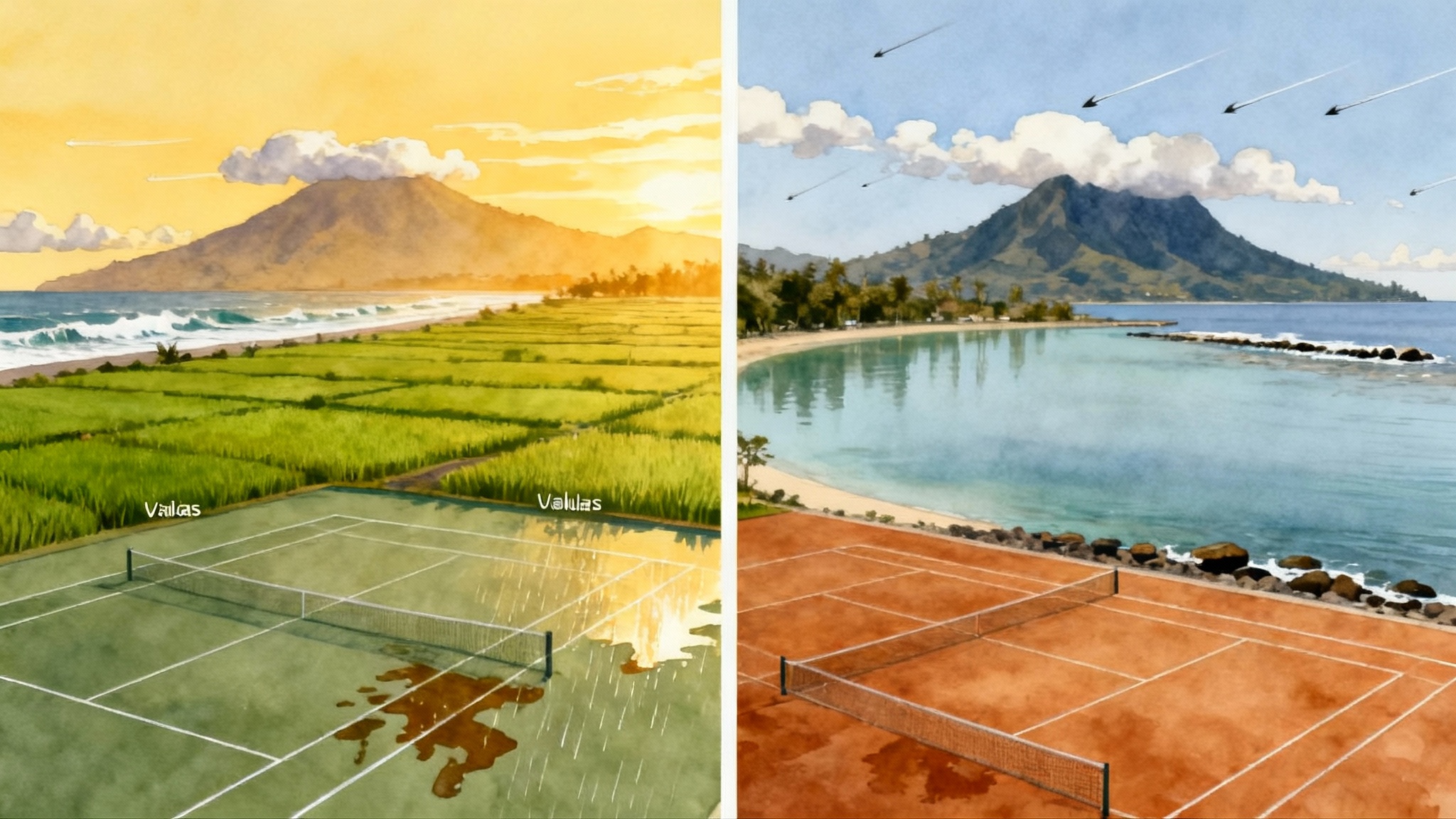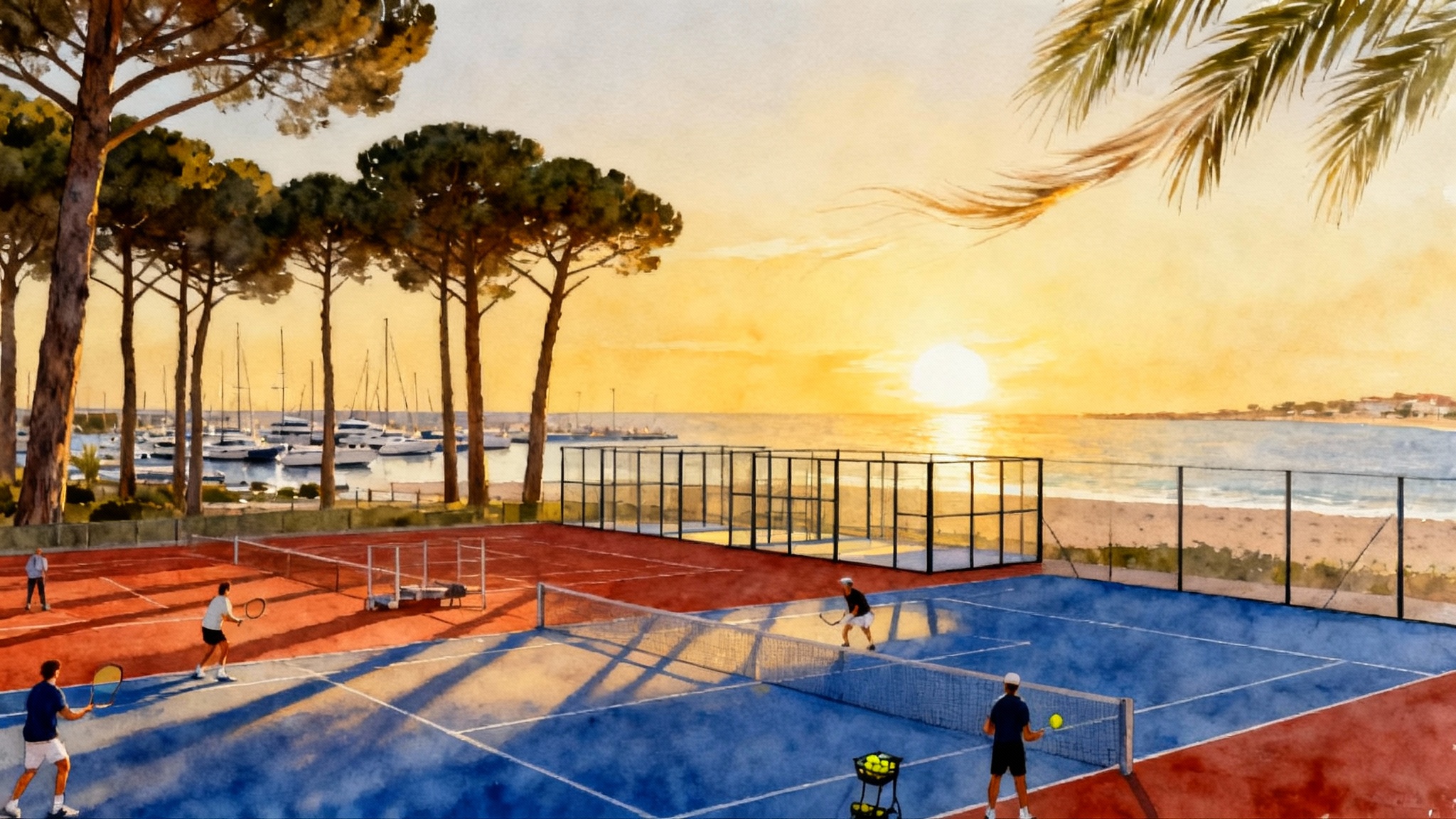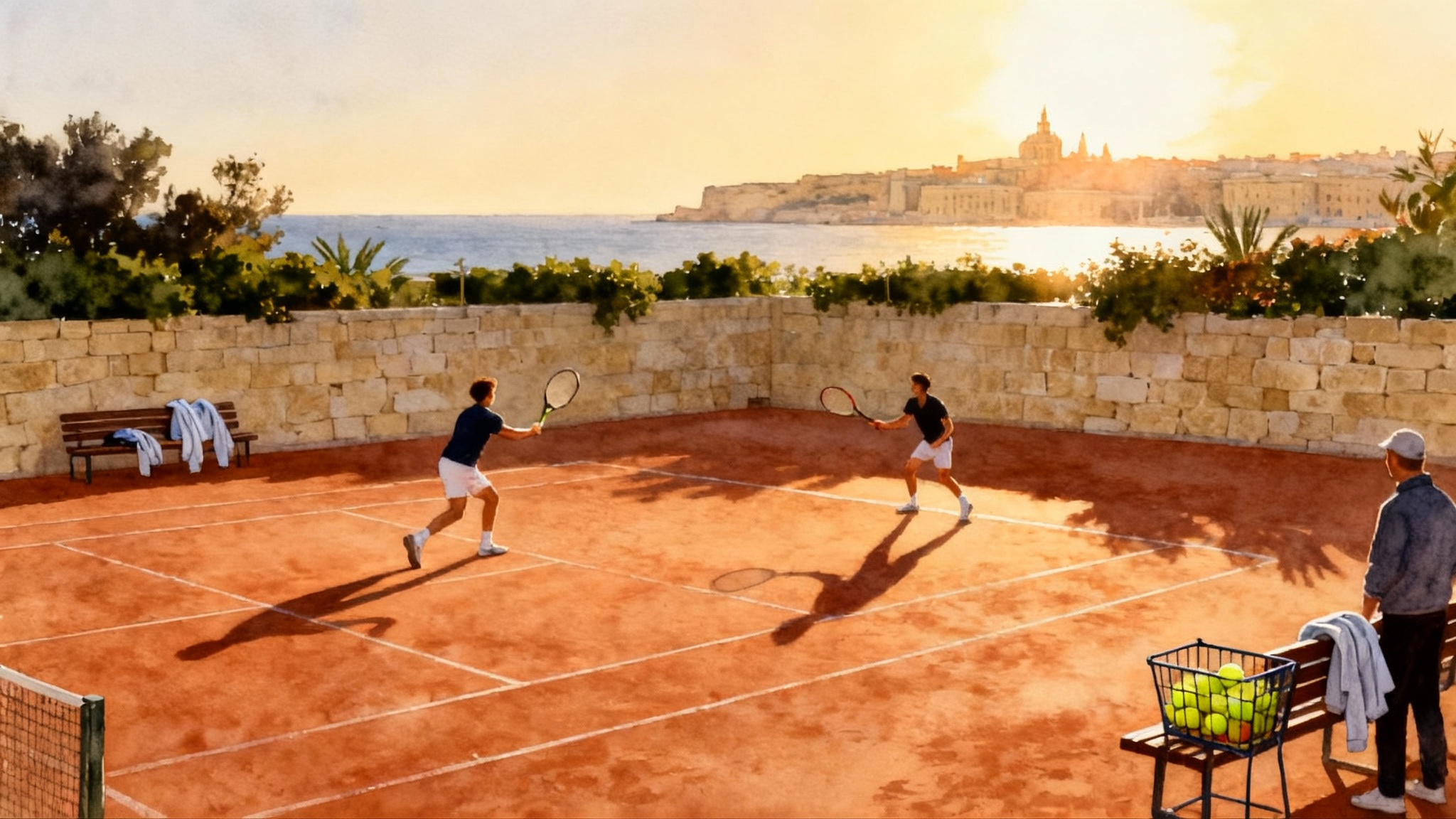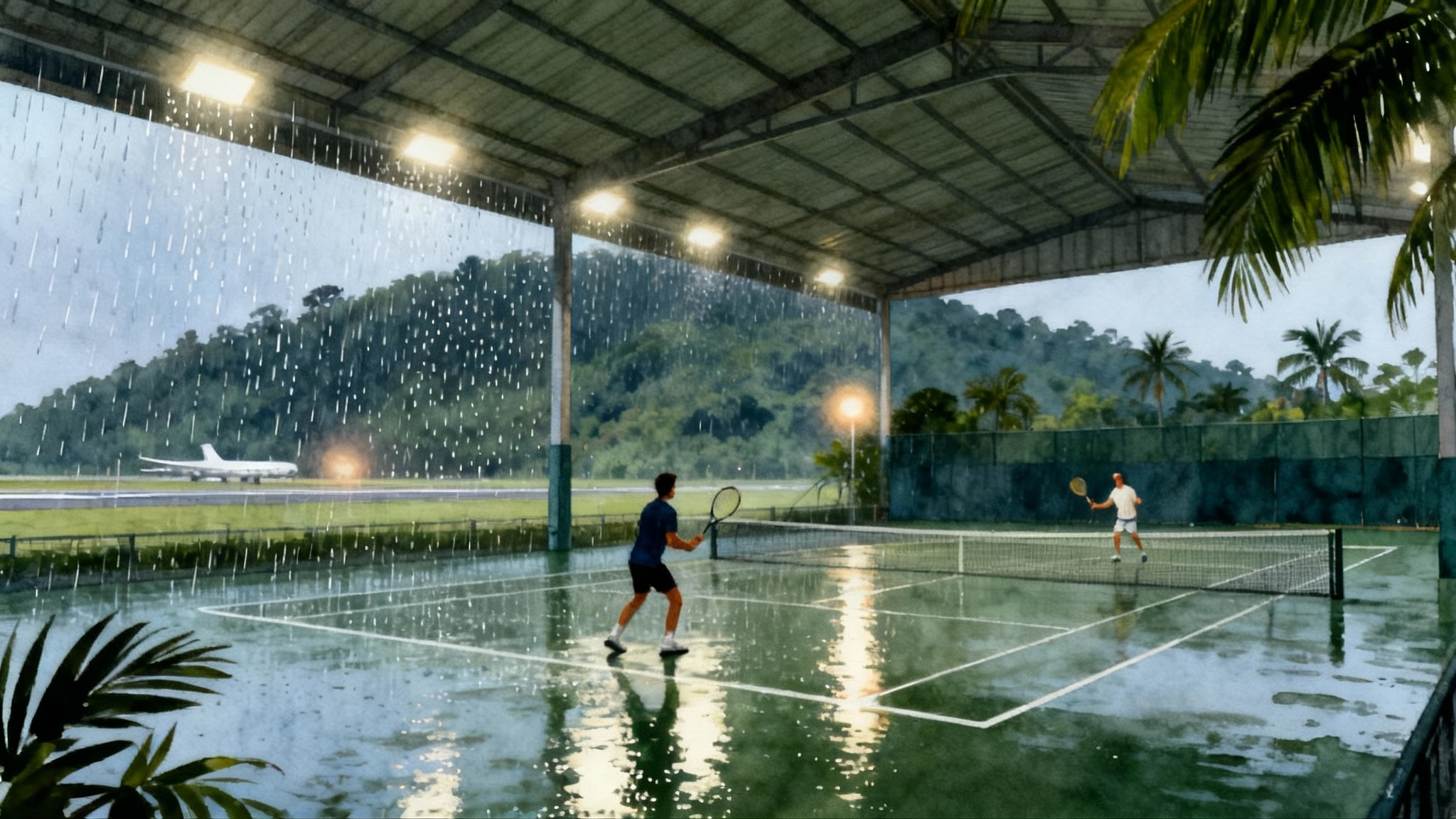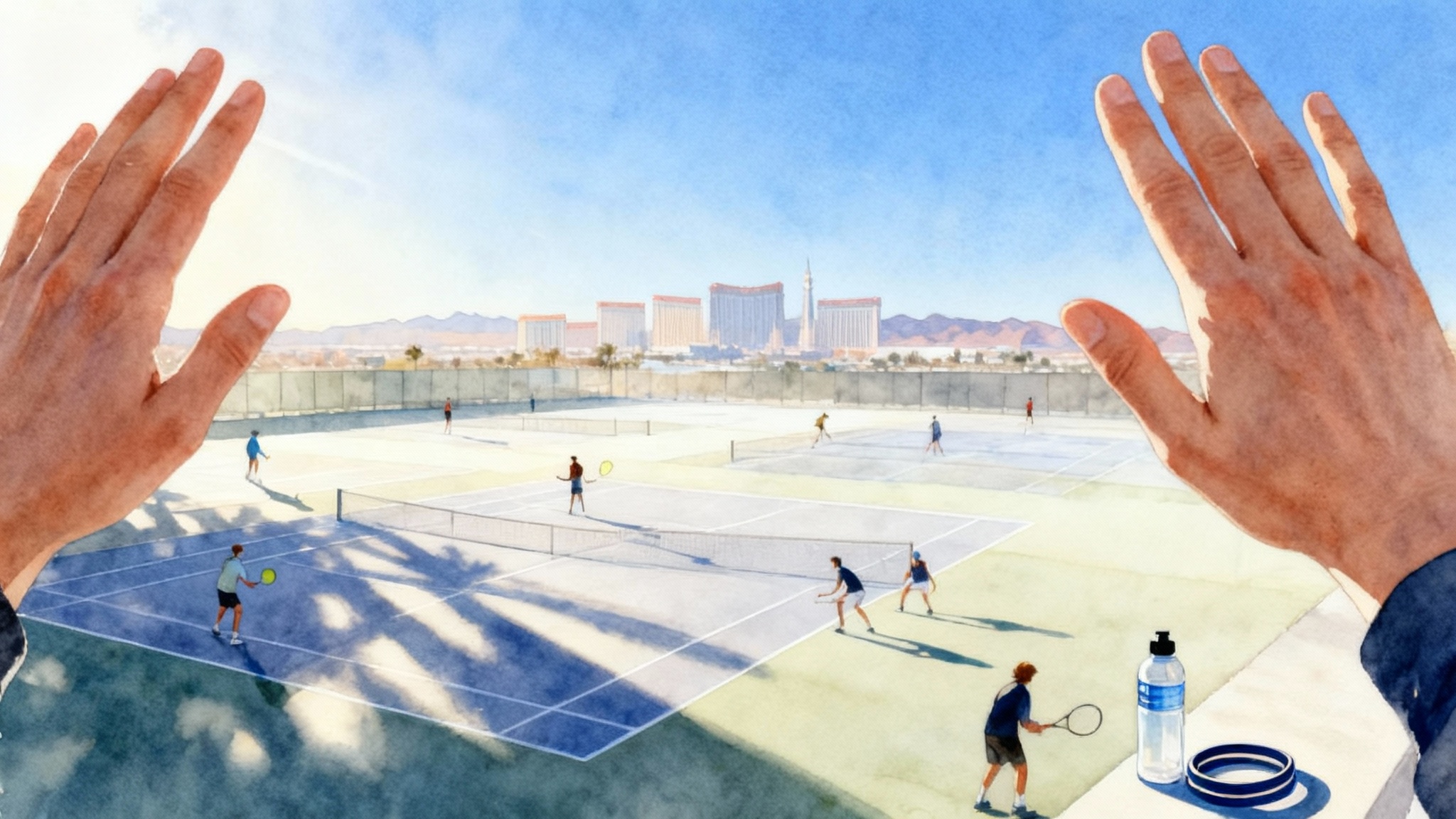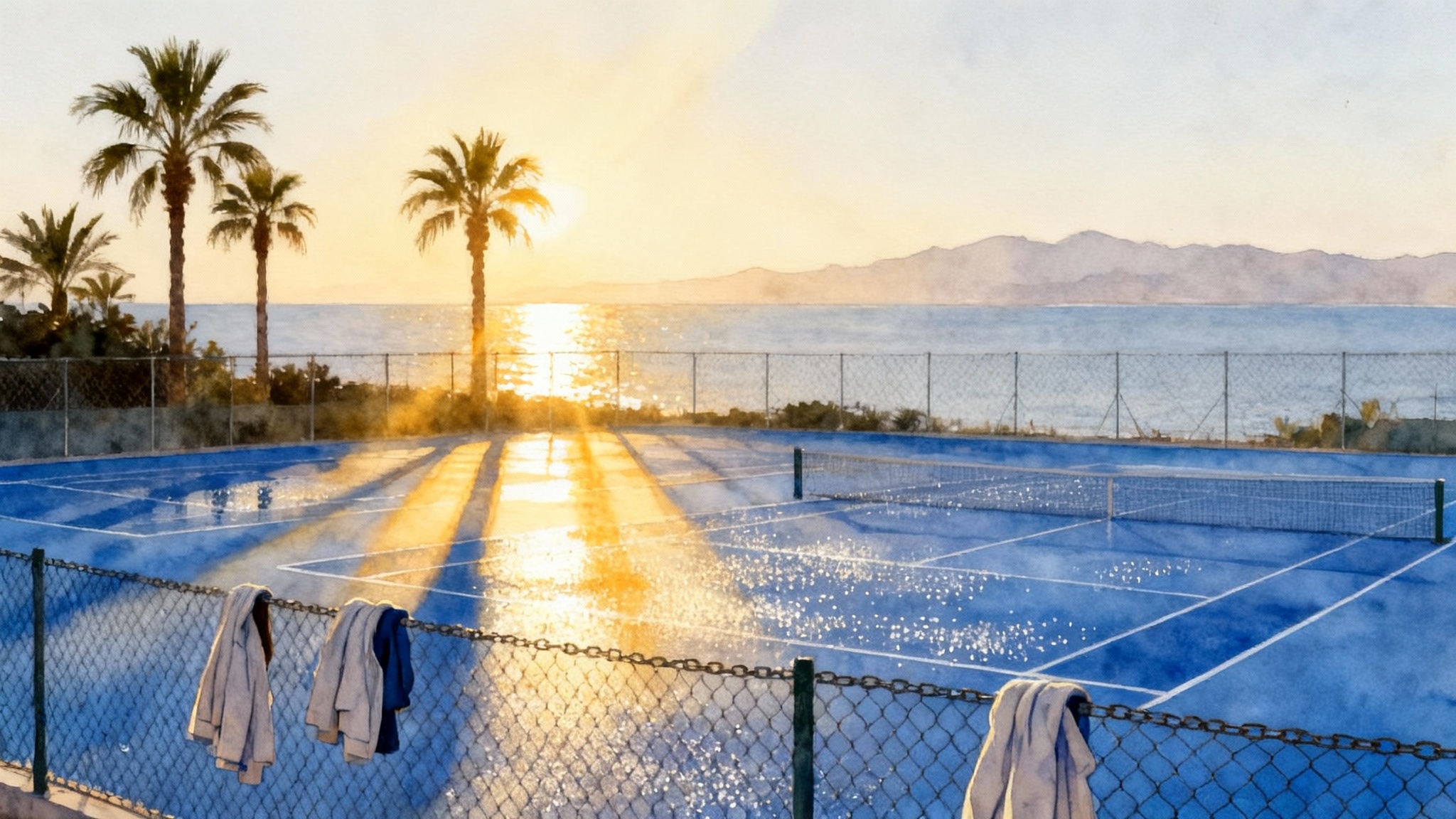Crete Shoulder-Season Tennis: Lyttos Academy Guide 2025–26
Planning a September–November or March to May tennis block in Europe? Crete’s Lyttos Tennis Academy offers reliable sun, true European clay, and resort recovery that make 7–10 day training weeks productive and stress free.
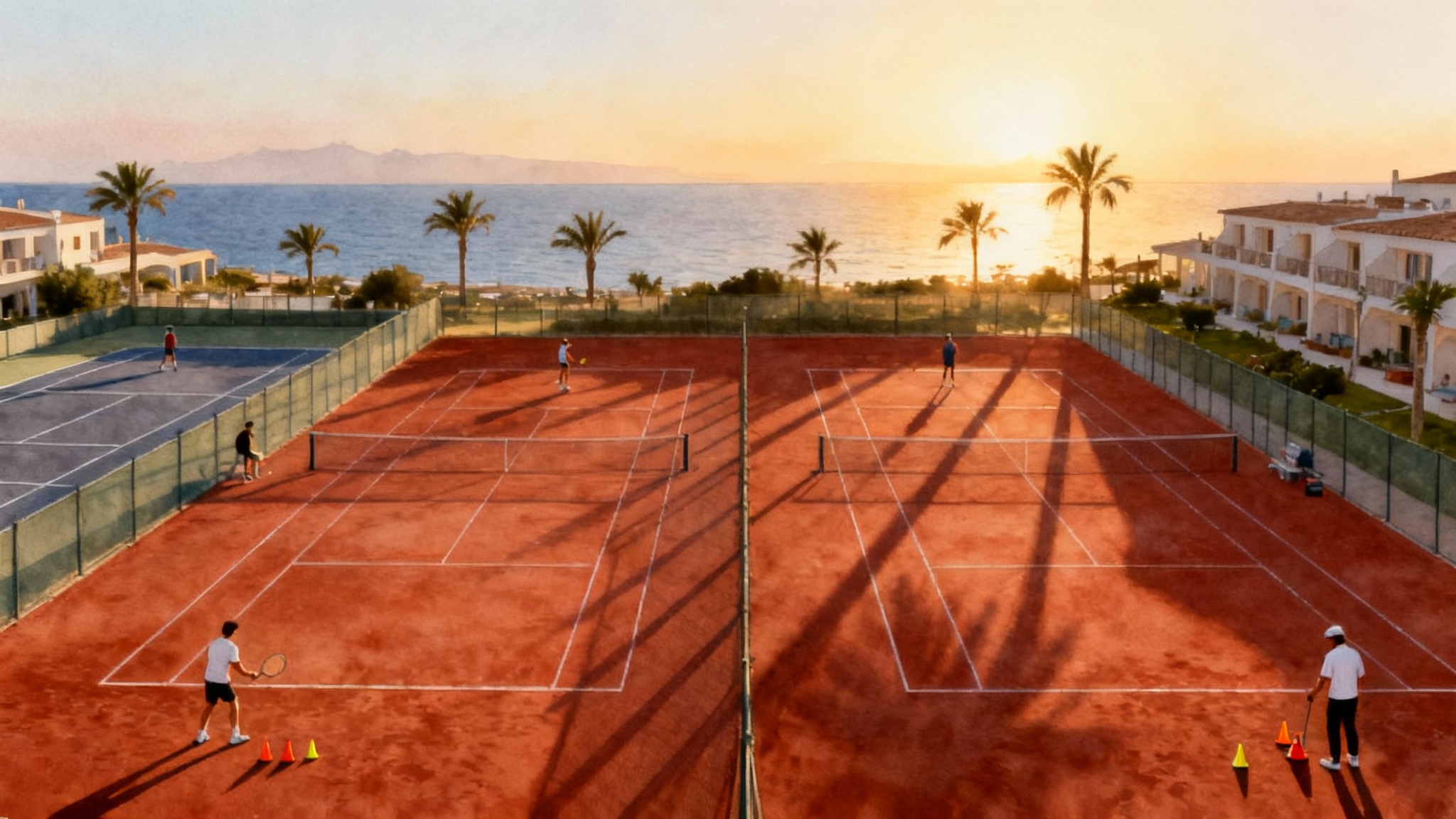
Why Crete is the most reliable sun and clay bet in the shoulder months
If you want real time on European clay without losing days to cold fronts or drizzly afternoons, the north coast of Crete is hard to beat. From early autumn into late fall, and again from early spring into late spring, the island tends to deliver long, playable mornings, mild temperatures, and a sea breeze that keeps courts comfortable. Mainland hubs can be excellent in peak summer yet get patchy in shoulder weeks. Crete’s position in the southern Aegean shifts the odds in your favor. For tennis families and performance players who only have one or two training windows a year, those odds matter more than postcard views.
Hersonissos sits close to Heraklion on Crete’s north shore. The coastline is open enough to breathe yet shaped by headlands that blunt the worst gusts. In September and October the strong summer winds ease, which means fewer balls sailing long and more time hitting your targets. In March, April, and May you get a quick jump into outdoor clay before most of mainland Europe finishes thawing. That timing lets you build match fitness and confidence before spring and early summer events. For a nearby winter alternative when days get shorter, see our take on sun-safe winter tennis in Cyprus.
The upshot is simple. If your calendar says September to November or March to May, Crete stacks the deck for good training days. That reliability is why Lyttos Tennis Academy on Crete has become a base for touring pros, juniors with European schedules, and adult groups that want serious volume without the gamble of northern rain systems.
Meet Lyttos Tennis Academy: a purpose built sun and clay campus
Lyttos Tennis Academy sits inside Lyttos Beach Resort in the Hersonissos area, so you live where you train. The academy spreads rows of European red clay courts alongside acrylic hard courts, with enough capacity to move groups through purposeful blocks without queuing. Clay courts teach patience, spacing, and balance. Hard courts keep your serve plus one patterns sharp and give you confidence on faster bounces. Switching between them inside the same week is a free upgrade in adaptability.
Court maintenance at Lyttos is professional. Clay stays even and watered, which reduces bad bounces and the joint stress that shows up when a surface gets too dry and gritty. Ball carts, target cones, and standard coaching tools are on hand, and there is space around courts for warm ups, footwork ladders, and resistance band activation. The pro shop can help with emergency stringing, and the resort layout makes it easy to do short recovery walks between meals, courts, and rooms.
The most underrated advantage is density. When accommodation, courts, meals, recovery pools, and beach paths sit within a short walk, you cut the friction out of your day. Fewer transfers means more balls hit and more time sleeping.
Competition you can plan for
Training volume is only half the reason athletes pick Lyttos. The other half is the steady stream of competitive opportunities on and around the campus. The academy and local organizers run regular match play, and seasonal blocks often coincide with international junior and professional events on Crete. That creates sparring and scouting chances, and it gives coaches a clear target when they build microcycles. Even if you are not entering a draw, you can set up high quality practice sets with visiting players on short notice.
The practical takeaway: when you build a 7 to 10 day camp, plan at least two match days. Put one early to test travel legs, then another late in the block to measure progress. Use the rest of the days for technical themes and specific patterns. Lyttos makes that structure easy because courts and opponents are close at hand.
Climate smart scheduling: how to win the day
- Morning priority: Book your heaviest technical or volume session from 08:00 to 10:30. The air is cooler, winds are typically calmer, and clay is perfectly watered.
- Midday split: From 12:00 to 14:00, use shaded conditioning, video review, and serve buckets. If you prefer to stay on court, switch to hard courts, where the bounce is truer if the breeze picks up.
- Afternoon targets: 16:00 to 18:00 is a good window for point play and serve-return games. Shadows lengthen, the sun softens, and players bring better focus.
- Wind days are skill days: If a northerly picks up, play crosscourt height control and body serve patterns. Wind reveals weaknesses in racket face control. Treat it as a free biomechanics teacher rather than a problem.
Two sample daily workloads
Below are proven shapes for a single training day. Adjust volume to age and training age. Always keep one session focused, one session playful, and one anchored to recovery.
Juniors performance day
- 07:15: Mobility, dynamic warm up, and five minutes of eye hand drills with a reaction ball
- 08:00 to 10:30: Clay, theme is neutral to offense. Progression: crosscourt heavy to depth targets, add direction change on short middle ball, finish with 11 point games where a break of serve is worth two points
- 12:00 to 13:00: Strength and conditioning. Emphasis on single leg strength and trunk rotation. Finish with a 10 minute cooldown walk
- 16:00 to 18:00: Hard courts, serve plus one and return plus one. Scored sets to four games with no ad scoring and a tiebreak game to seven at 3 3
- 19:30: Nutrition focus on carbohydrates to refill, plus protein for repair. Ten minute stretch before bed
Adults serious day
- 07:30: Joint prep and five minute skipping routine
- 08:15 to 10:15: Clay, theme is length and height. Drills: crosscourt deep box, approach plus volley patterns, transition games to seven points
- 12:30 to 13:15: Pool recovery and breathing, then lunch
- 16:30 to 18:00: Point play ladder, two short sets. Finish with serve targets, 30 balls to three corners
- Evening: Walk the beach path, hips and back stretch, quiet lights out
Build a 7 to 10 day block that compounds
Use this blueprint as your base. If you travel with a coach, they can tune themes. If you do not, keep the structure and stay honest with effort ratings.
Day 1 arrival and reboot
- Light shakeout hit on hard courts, 60 to 75 minutes
- Mobility and a long walk. Early dinner, early bed
Day 2 clay immersion
- Morning: 2 hours of crosscourt control on clay. Focus on footwork patterns and balance after contact
- Midday: Strength and conditioning, 45 minutes
- Afternoon: Serve practice, 45 minutes
Day 3 patterns under pressure
- Morning: 2 hours on clay. Add direction changes and make patterns predictable for your partner, then hide one surprise ball per rally
- Afternoon: Practice set or tie break sets on clay
Day 4 mixed surfaces and match play
- Morning: Hard courts, first strike patterns for 90 minutes
- Afternoon: Match play on clay, one set to six or two fast four sets
Day 5 recovery with accuracy
- Morning: 60 minute technical serve session, then 20 minutes of soft hands drop shot and touch games
- Afternoon: Pool, beach walk, stretch, and early night
Day 6 repeat the strengths
- Morning: Clay, build confidence by repeating the themes you owned on Day 3
- Afternoon: Match play ladder with new opponents. If no group is available, play situational games to 15 points
Day 7 flight day or bonus day
- If leaving, schedule a short hit before breakfast
- If staying, insert a full rest morning, then a fun doubles afternoon
Days 8 to 10 build to a peak
- Two more pattern days and one final match day. Use video on one morning to lock in a single technical cue that traveled well all week
You can save this framework to your phone or adapt it in our simple planner via the TennisAcademy.app training planner.
Recovery you will actually use
Recovery only works if it is convenient. At Lyttos, pools, beach access, and quiet shaded areas are steps from the courts. That turns good intentions into real habits.
- Cold to warm contrast: Five minutes in the cool pool, three minutes air warm up, repeat twice. This reduces the heavy leg feeling from long clay sessions.
- Sleep as a performance tool: Keep your room cool and dim. Use a consistent wind down routine at the same time each night. Your next day depends on this more than any supplement.
- Food flow: Breakfast after the early session, a protein rich snack after strength, and a carbohydrate biased dinner after afternoon points. Simple does the job if timing is right.
- Feet first: Clay can rub. Bring two pairs of socks per playing day, one pair of clay court shoes, one pair of hard court shoes, and tape for hot spots.
Travel logistics to Heraklion and Lyttos
- Arrival airport: Heraklion International Airport, code HER, sits on the island’s north coast. Flights connect directly from many European cities in season, with year round links via Athens.
- Transfer time: The resort area near Hersonissos is a short drive from the airport, which keeps fatigue low after travel days. Taxis and ride services are available on arrival, and rental cars are simple to collect.
- Ferry option: If you prefer to skip flights, overnight ferries run from Piraeus near Athens to Heraklion. An evening departure and early morning arrival lets you check in and train the same afternoon.
- Local errands: A short walk or quick drive gets you to grocery stores for fruit, water, and simple snacks. Pharmacies carry sports tape and sunscreen.
- Connectivity: Hotel Wi‑Fi handles video review and calls. If you want local data, prepaid cards are easy to pick up at the airport.
Budget tips for families and for serious players
Families
- Travel windows: Prices are more forgiving in late September, October, and early November, and again in March and April compared to peak summer. Arrive midweek if possible.
- Room choices: Garden view or family rooms close to the courts reduce walking time and cost less than prime sea views. The shorter walk matters for naps and snacks with young kids.
- Meal plans: Half board gives flexibility for a light lunch by the pool or on the beach. Pack reusable water bottles and snack boxes to control sugar swings between sessions.
- Court sharing: Book adjacent courts for parents and kids at the same time so warm up and cool down can be done together.
- Laundry plan: Quick dry training kits and a small travel detergent keep baggage light. Washing between sessions means everyone has a fresh kit for the afternoon hit.
Serious players and teams
- Volume pricing: Ask for multi day or multi court packages. When you book blocks, you can often lock preferred times and keep costs predictable.
- Bring a string plan: Travel with a reel of your preferred string, a backup hybrid, and overgrips. Even with on site stringing, your own reel protects your feel and budget.
- Train to the climate: Build early sessions, plan shade at midday, and keep afternoon point play short and sharp. Setting your timetable to the environment keeps both performance and the cost of extra recovery low.
- Shared services: If you do not travel with a coach, pair with another player or small group for hitting sessions and video review. Split court time and balls.
- Tournament weeks: If your dates overlap with events, book earlier and confirm the exact number of courts you will need, then plan to match play on non competition slots. For a western Europe comparison, see our Algarve shoulder season tennis guide.
Wind and rain: what to expect and how to adapt
Rain in these months is usually short and workable around. Clay crews at Lyttos are used to quick squeegee and broom cycles, and hard courts drain fast. On a wet morning, flip the plan. Start with strength and conditioning or a pool recovery routine, then roll onto the courts as they open.
Wind is part of island tennis. Instead of fighting it, build goals around it.
- Upwind baseline: Aim two strings higher on your racket face through contact, work heavy crosscourt depth, and attack only when feet are perfect.
- Downwind baseline: Aim shorter, take the ball earlier, and finish points at the net or with body serves.
- Crosswind: Go crosscourt more often to play with the big part of the court. Serve body and jam. Keep slice low on the windward side.
Treat a windy afternoon as a high quality skill lab. The next dead calm match will feel simple by comparison.
Packing list that saves sessions
- Two pairs of court shoes, one tuned to clay, one to hard
- Eight to ten pairs of socks for a week, plus blister tape
- Two hats, polarized sunglasses, and high protection sunscreen
- Preferred string reel, grips, lead tape, dampeners, and a small toolkit
- Resistance bands, a jump rope, and a lightweight massage ball
- Light layers for mornings and evenings, a compact rain shell, and a breathable long sleeve top
- Reusable bottles, electrolyte tabs, and a small first aid kit
- Travel adapters for European plugs and a power strip for devices
A final checklist before you book
- Dates: Choose September to early November or March to late May to maximize playable hours
- Intent: Decide if the week is technical rebuild, match play focus, or a balanced mix
- Surfaces: Pre book clay for mornings and hard for afternoons to get the best of both
- People: Confirm sparring lists and, if needed, set up one or two practice matches before arrival
- Recovery: Block time in your calendar for pool, naps, and early lights out, the simplest performance enhancer you have
The bottom line
When you mix Crete’s shoulder season reliability with a campus built for tennis, you remove luck from the equation. Lyttos gives you true European clay, hard courts for first strike patterns, and a resort layout that turns recovery into an easy habit. Build a clear 7 to 10 day plan, schedule match days, and let the island’s climate do its quiet work. When you fly home, you will have more balls struck, more patterns rehearsed, and more confidence than if you had waited for a perfect forecast somewhere else.
